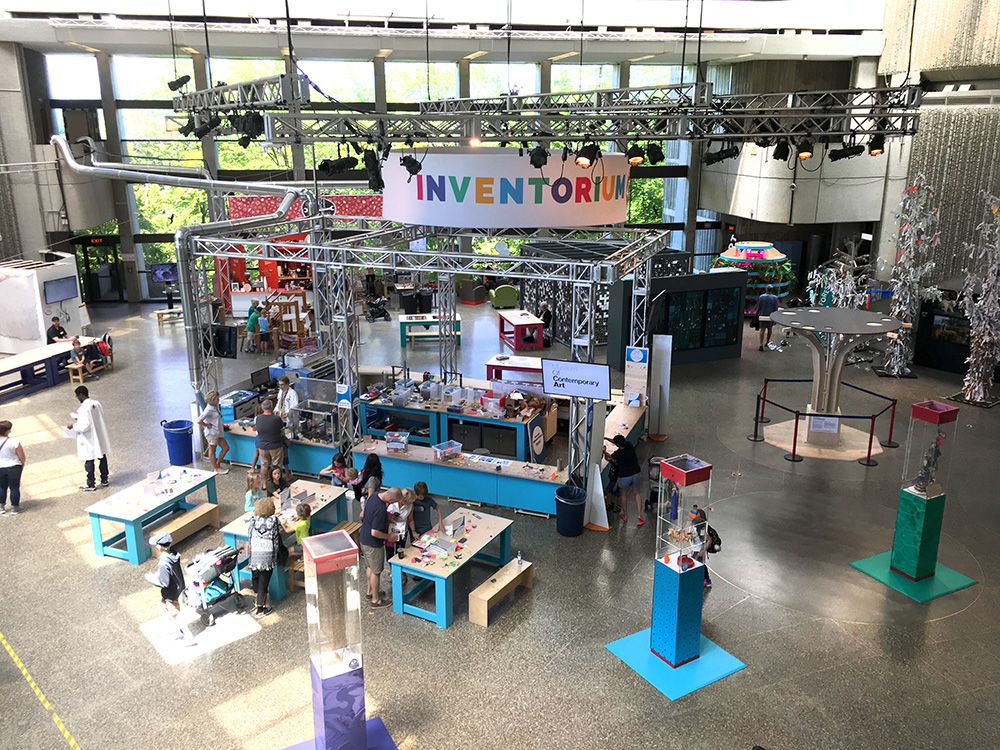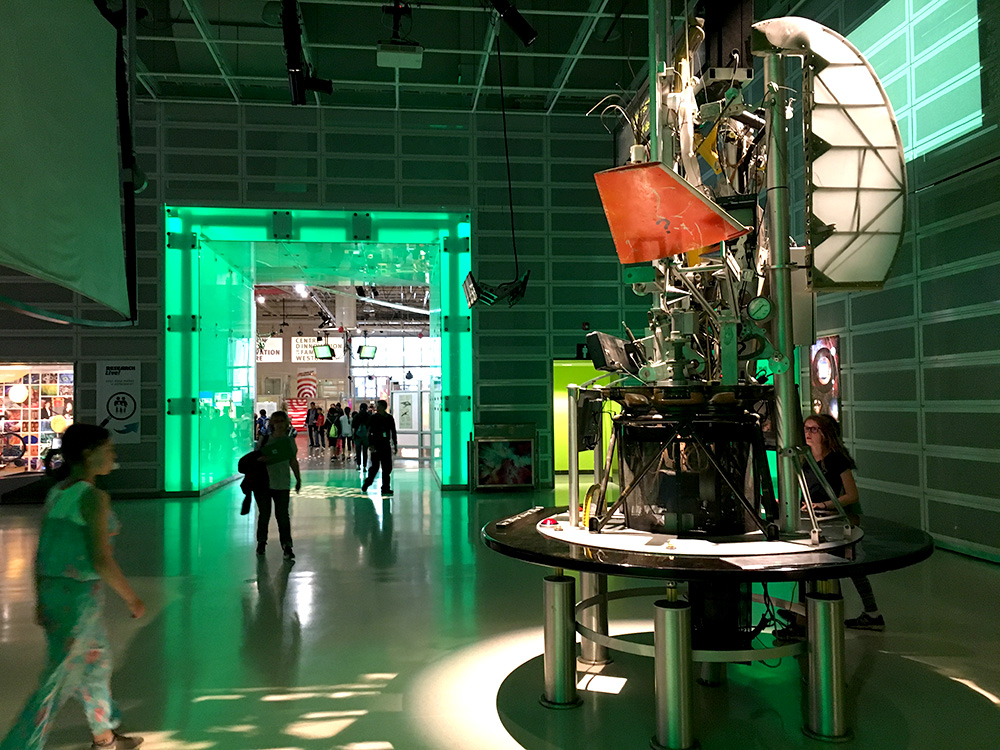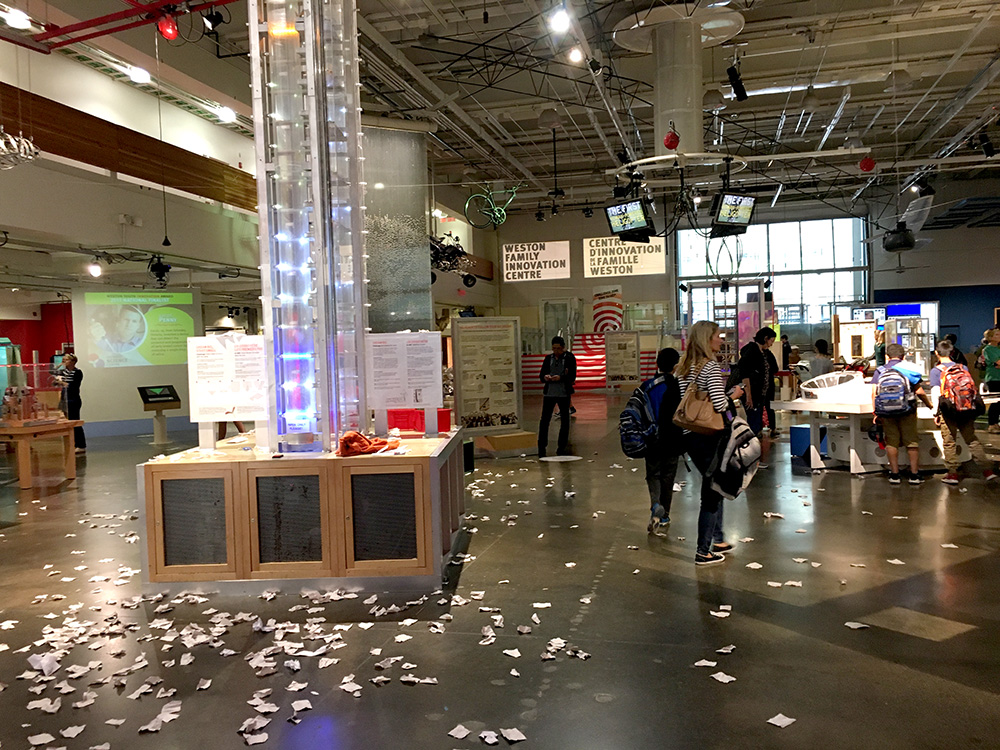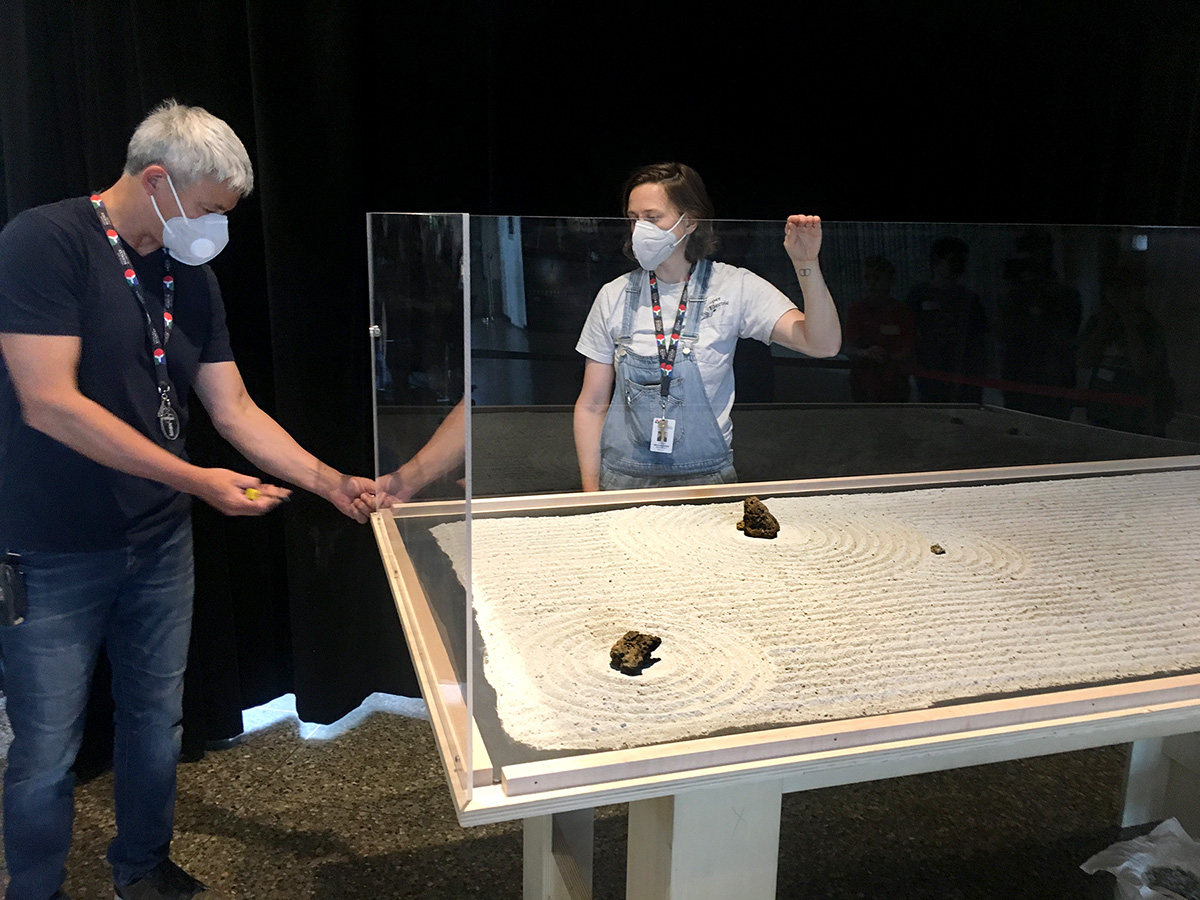It is hard to imagine that 50 years ago humanity finally visited the Moon.
On July 20, 2019 we are celebrating the 50th anniversary of the Apollo Program. Here I would like to tell you about my art project made for this occasion.
How it started.
Earlier this year I traveled to Japan for a science meeting of ESA and JAXA on the BepiColombo space mission to Mercury. After the conference I was invited to visit JAXA in Tokyo. There, I got my inspiration after seeing the lunar yards. A massive room was filled with sand replicating the surface of the Moon to test lunar rovers. The room was very dramatic with intense light hitting the sand sideways. We were instantly transported to our planetary satellite. A couple of rovers slowly moved across the “lunar” landscape creating intricate patterns on the sand.
I thought back then, it would be very cool to get ahold of this kind of sand for an art project. But this was very special sand and impossible to get. I wasn’t even sure what I could do with it quite yet. After that I went on a long journey around Japan and observed a lot of Japanese rock gardens, including the most famous ones like Ryoan-ji and Ginkaku-ji in Kyoto.
The idea came about when I was back in US: I must make a Japanese rock garden using special lunar sand!
It happened to be that the stars aligned and I was very lucky to find a perfect place to install my garden. This year I was selected for an art residency at the Ontario Science Center in Toronto, Canada. I knew that they would be celebrating the Apollo anniversary and I decided to propose the idea. The Ontario center is mainly focused on educating kids, so even though they loved my idea, I was asked to design it so kids could interact. So the alternative plan was to make a sand play box using the same sand I saw in JAXA. But that sand was just impossible to find!
After some further research I discovered that there is a Florida based company that makes a proper lunar soil simulant. This material was the real deal, by just looking at it it was clear that this is what you see on the Moon. In both composition and appearance it was made to be a copy of the one on the Moon. Though due to the fact it is very powdery and contains particles of glass, no way kids could touch it. So, the sand box idea fell apart.
Ana Klasnja, the curator of the art program at the Ontario center, an incredible lady who supports the connection of arts and science, found out that there is lunar soil simulant made locally in Ontario. So I am that lucky artist who got a whole box of it for my project! Unbelievable. By the time I got to Toronto, anorthositic Lunar regolith simulant ChEnOB1 was already waiting for me, along with a large glass covered table on which I would install my garden.
On my way to Toronto I spent a week in Gloucester, MA. Almost every day I would go to the shore to practice raking the sand, I have never made a rock garden before, so I was very worried if I would be able to do it. The whole idea behind the rock gardens is to get close to inner peace. Beautiful New England Atlantic landscape was helping me find that zen moment. I made a special raking tool, that appeared quite wabi sabi and ordered a miniature rock garden tool set online, so I was enjoying my practice on the shore.
My goal was to design a pattern to represent artificial nature, just like any other Japanese rock gardens would do. The idea of the rock garden on the Moon made a lot of sense as there is no living nature or liquid water, and I am to create a representation of it in a hostile lunar environment. Straight lines that my tool would leave on the sand would represent oceans, wavy lines - rivers, circular patterns - waves on the water (as well as craters in my case), rocks - mountains.
Rocks.
This detail requires some explanations. In my original Idea I wanted to make 3D models of real moon rocks. After quite a bit of research I realized that nobody made such 3D models. Well, there was one institution which made a rock using lunar materials! But this was out of reach. I couldn’t even find photographic data to be able to make my own 3D models. So the alternative was to use terrestrial rocks. A scientist confirmed that they are also very close in composition to the the lunar ones. During my travels to volcanic areas I have collected a set of rocks in various sizes, so they worked wonderfully and appeared so similar to some found on the Moon. The Moon too had volcanic activity long ago (100 million years ago). So I packed up my rocks and traveled with them to Canada.
Installing.
Once I got to the Ontario Science Center, I was impressed how massive it was, many floors of exciting scientific displays and 90% of them were interactive. Such an honor to be working here! Magnificent Ana helped organizing every little bit for my project. I was introduced to a team of professional makers, people who had massive workshops (wood, metal and so on) behind the curtains of the center. If there was anything, they make it happen. Indeed, an artist’s dreams come true. But there was no time to relax and dream.
I must say, this project was a personal challenge for me. Making rock gardens on the deserted shores of Gloucester, was NOTHING compared with what I faced at the center. Starting at 10 am the center is stormed by thousands of kids. The non-stop noisy chaos lasts all day long. On my 1st day of installation I was preparing my space and materials, my area was protected by a rope so I wouldn’t be disturbed. But of course a couple of red ropes would not stop kids from sneaking in. I would sometimes be surrounded by 20 kids at once and they all wanted to ask questions. I quickly realized that the installation of this artwork must happen before opening hours.
On my next day I started working at 8am and only had 2 hours to start and finish the rock garden. Which is extremely short time to complete the work. Curious workers of the center would still be coming by and asking questions, which I could not answer due to the lack of time.
There was another issue. The lunar soil acted very different on the 2nd day. It was much more softer and powdery, which made it difficult to work with and create patterns. There must have been moisture in the mix, which evaporated over the night. From the patterns I left the day before I could see that they became less sharp and all of the corners got smoothed out. I thought then that there is a chance that in few month the whole garden will be totally flattened, and in a way I was intrigued by it and not discouraged.
During the creation of a rock garden one must find peace and focus only on the present moment, which is the moment of rock garden making. In my case, this was the hardest part of it all. I made a decision that I should start practicing meditation to help me in my future work. Indeed, in the middle of the total chaos with a strict time pressure I was trying to make a representation of zen space. What an absurd idea. But there is no limits to art and one must overcome personal challenges.
I don’t know how, but the garden was finished, and at 9.45am my helpers were already standing by waiting to put the glass cover on for the day, so no kids could touch the exciting lunar soul.
Tools.
I knew that working with powdery soil material will be very different from sand. So the raking tool I made was not good enough. But I was lucky to be right next to the so called “exploratorium” where kids could study how to create cool things, including 3D printing and laser cutting. So master creators at the exploratorium were very kind to help me out and laser cut a bunch of tools that I designed right than on Illustrator. After that, I took the cut out raking shapes to the wood workshop and thanks to the wonderful masters my finished tools were waiting for me the next morning. I don’t know what would I be able to make if I didn’t have those tools. So I would like to say thanks to everyone who helped me out! You guys are awesome!
Music.
A very exciting thing happen, I had a chance to collaborate with extraordinary musicians Andrew Santaguida and Matt Russo. They are also taking an art residency at the Ontario Science Center, so we were introduced. They created this beautiful zen composition to go along with the rock garden. What makes it even cooler is that it is based on the topography of the moon. It is indeed a wonderful addition to the installation and I am honored to be able to work with such talented composers.
Filming.
On my third day, I had a documentary filmmaker Shelley Ayres come over. I met Shelly during my project about the Rosetta space mission. She visited my studio in New York and made a small feature about my artwork on Rosetta for the Discovery Channel. Shelley came over to help document my artwork once again. We had to start working early, before the opening of the museum. I must say I was very impressed with Shelley’s professionalism once more. All of her actions and they way she interviewed me speaks of a true master of documentary filming. By the way, specifically for the 50th anniversary of the Apollo Program Shelley and Mark Foerster made a short film which will be streamed at science museums. So keep an eye out for it.
This blog post came out very long, but now you get to understand that even behind a very simple thing as a rock garden stands a lot of work, there are so many people involved to make this happen and a lot of challenges had to be resolved. Over all this was a great experience and helped me grow as an artist. I am inspired to create a permanent rock garden in a forest where we have a cabin, as I feel like this would be many years of self training meditative experience.
Now, find my Lunar Rock Garden.
Imagine yourself sitting alone in the most tranquil place on the Moon, Mare Tranquillitatis, the landing site of Apollo 11. Observe this rock garden. Watch the stones, sitting among you motionless for millions of years, only the strokes of imaginary water slowly move around them, and you. Think of life and its true meaning. Perhaps in the lunar surrounding where life is absolutely impossible due to the lack of liquid water, organic matter and life supporting conditions, you will come to the answer of the true meaning of life.



















